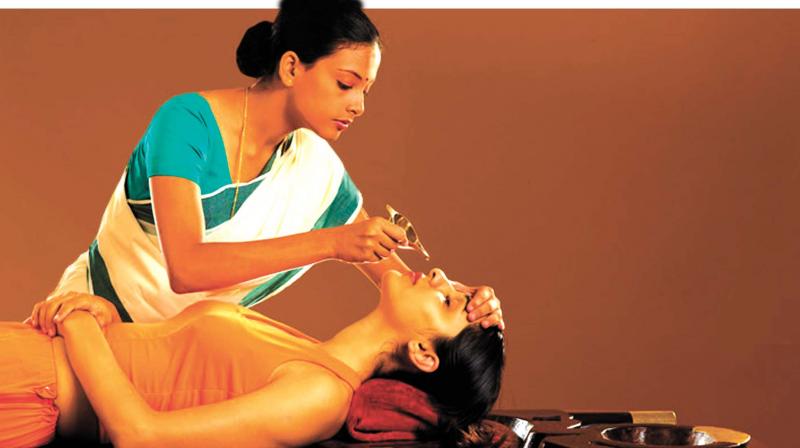National Ayurveda Day: On your heels, chase diabetes

The Indian Government’s decision, though belated, to observe October 28 as National Ayurveda Day is proof that our own traditional system of medicine has finally received a very deserving national and global attention. The increasing burden of existing and emerging diseases and gaps in modern medicine in dealing with the challenge along with setbacks like antibiotic resistance stress the need to include indigenous systems in mainstream medicine. This year’s theme is ‘Ayurveda for the prevention and control of diabetes’, taking into account the fact that India is among top three diabetic centres in the world.
Last year the Nobel for physiology or medicine was awarded to Ms Tu Youyou, a Chinese pharmaceutical chemist for discovering compounds to treat malaria. Her discovery of artemisinin and its treatment of malaria are a significant breakthrough in tropical medicine in the 20th century. Her discovery was based on Chinese traditional medicine. But, in taking traditional Chinese medicine to the Nobel hall of fame, she had received unflinching support from the faculty and authorities. The world needs Ayurveda now more than ever, given the nature of the epidemic; we can take it to Nobel heights and beyond, but needs to give it more focus.
There is a certain pattern in the way we encounter the disease. We check blood sugar level, probably in early middle age and discover we are ‘diabetic’. Then start the regimen of exercise - rigorous diet control and medicines, including tablets and injectable insulin. But by then we had adopted a lifestyle. Most of us are content to continue with it but struggle to change on medical advice. WHO’s global report on diabetes in 2016 estimates 8.5 percent of the affected world population reflect an increased association with risk factors such as being overweight or obese. Diabetes prevalence has risen faster in low and middle income countries, including India.
Ayurveda identified diabetes as a larger entity, associating it with obesity centuries back. We will be astonished to know that the modern treatment for diabetes and obesity is almost the same as described in Ayurveda. Madhumeha among 20 types of pramehas is close to present day diabetes mellitus. The reasons for this disease include lack of physical activity and uncontrolled, irrational food intake. Modern science has unraveled the preventive aspects of specific diseases. But Ayurveda incorporates a daily regimen and diet. The need for daily exercise and healthy eating habits is described in Ayurveda. You have to follow the regimen, or otherwise diabetes and many other ailments will follow.
There are types of diabetes as we know now. During 2nd BC there was no such understanding. In Ayurveda, exercises prescribed for the patient are to dig a well or graze the cow for the whole day, feeding on whatever is available and walk long distances. If you think this is rubbish, check WHO global diabetes report. It recommends 60 minutes of moderate to vigorous physical activity for age group 5-17 and 150 minutes of moderate or 75 minutes of vigorous physical activity daily for the age group 18-64. It is in line with Ayurveda. Diabetes prevalence reduced in Cuba during the economic crisis, courtesy an increased physical activity and less fatty but healthier food. But we do not have to import an economic crisis to become healthier!
Ayurveda had identified congenital factors and has a programme from life to death, from womb to tomb. It is the science of life. The diet should be less in fat and rich in fibre and protein. The role of medicine in the management of the disease has been limited to the minimum as it rightly identifies the importance of diet and physical activity in the ‘dinacharya’. Medicines are often simple containing mainly turmeric and gooseberry and inpatient treatments are also mentioned in detail. But with advent of easily accessible oral hypoglycemics and insulin, modern medicine offers easy solutions. This is inevitable in preventing and delaying life threatening complications. Along with modern medicine, Ayurveda can contribute much to the prevention and control of this killer disease.
In the future, inspired by Ayurveda, if a Ms Tu Youyou from India discovers a solution for diabetes, most probably we will struggle to source the drug in desired quantities because of deforestation and lack of initiatives to protect and propagate our precious medicinal floral wealth. With India’s commitment to reduce emissions in Paris 2015, we need to plant more trees and if planned well, that can add to our traditional medicinal plant sources for future. Let us change our food from junk to vegetables and fruits, from fries to whole grain cereals, let us get down from our bikes to bicycles and from four-wheelers to our own feet, which will make us healthy and wealthy and keep less polluted. Let us play shuttle badminton, football or at least walk for a while every day enjoying the nature around us. Run away from diabetes on your own feet. However rich you are, you cannot outrun nature.
(Author is medical officer at Government Ayurveda Dispensary Erattayar- Idukki/Ph. 9447968932 jineshjmenon@gmail.com)

